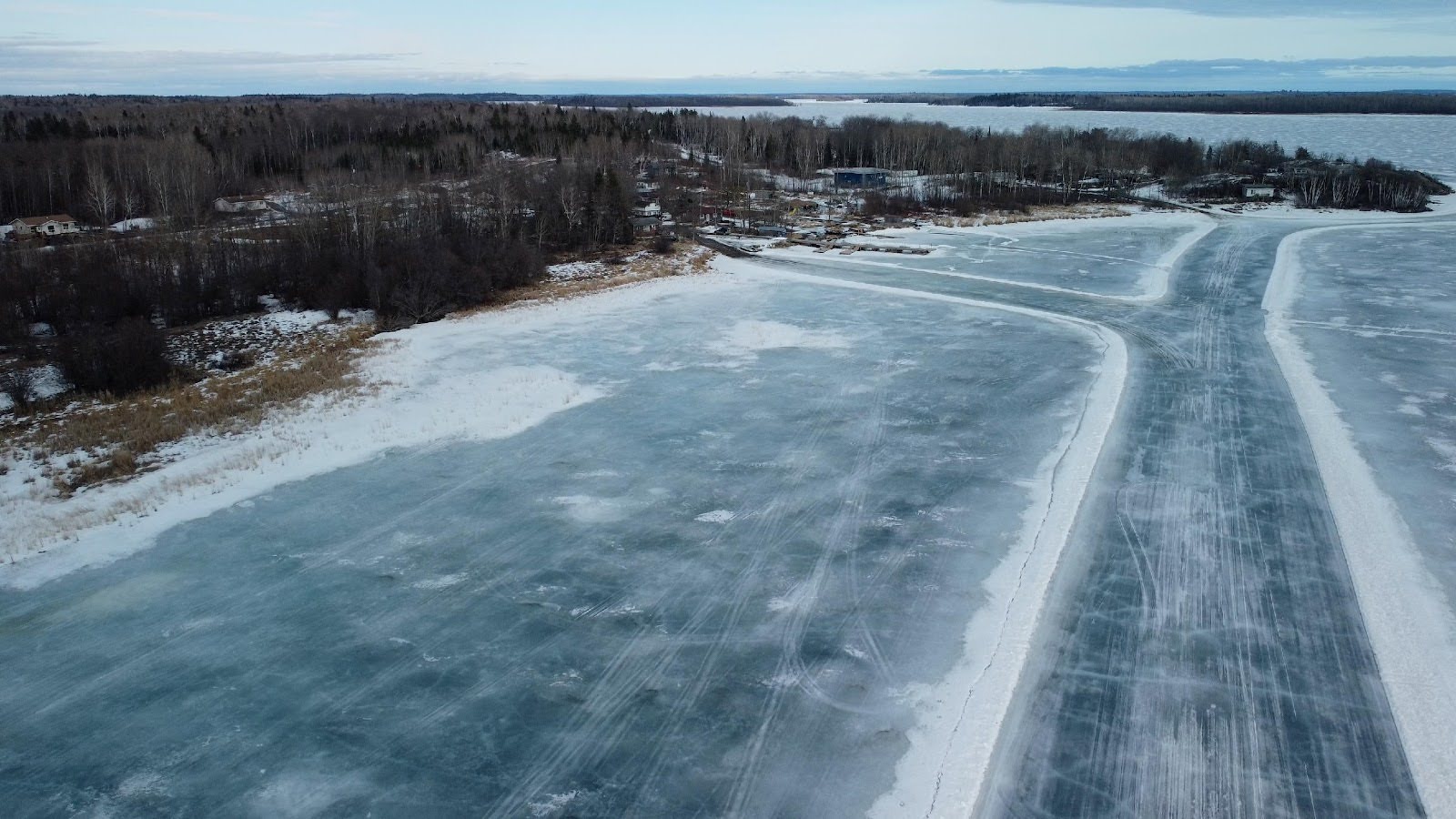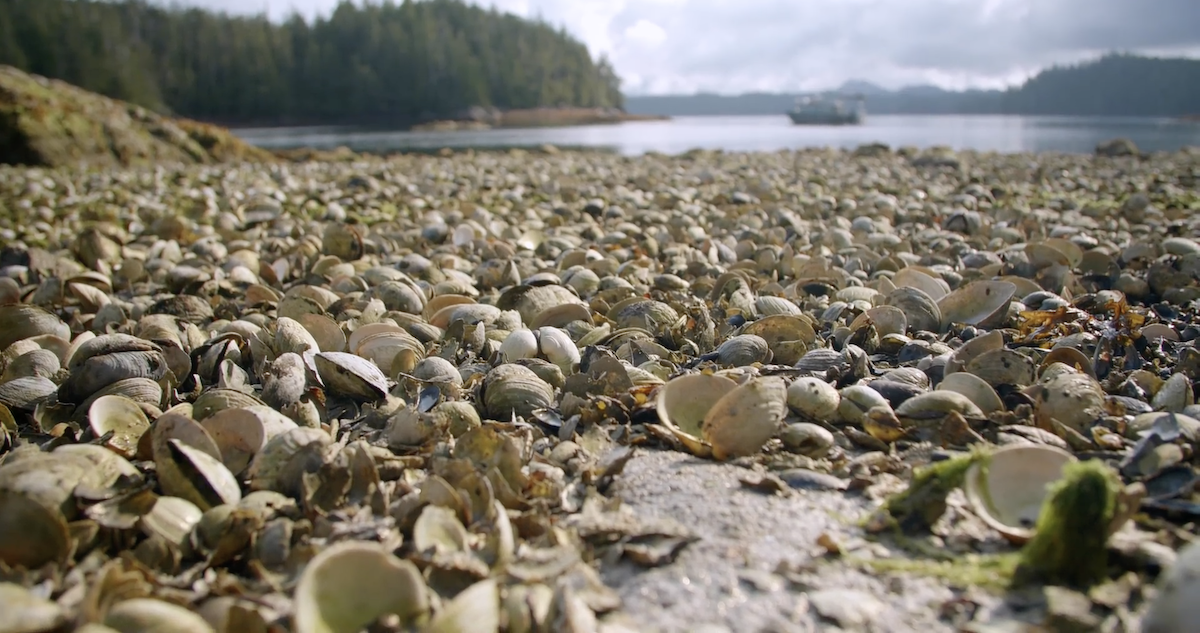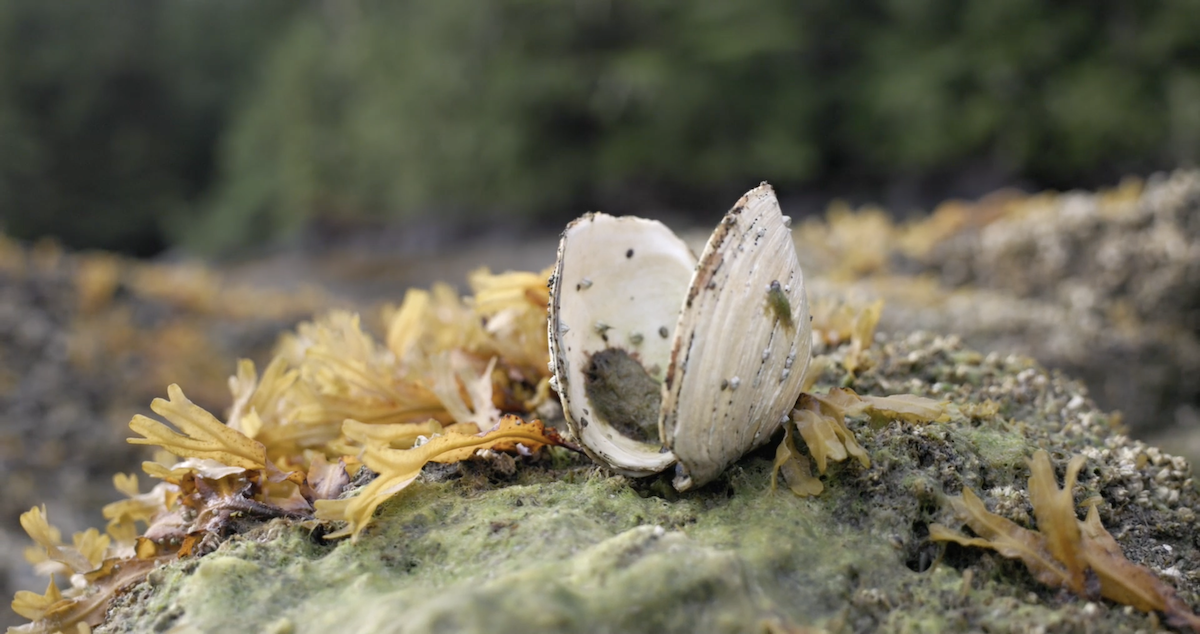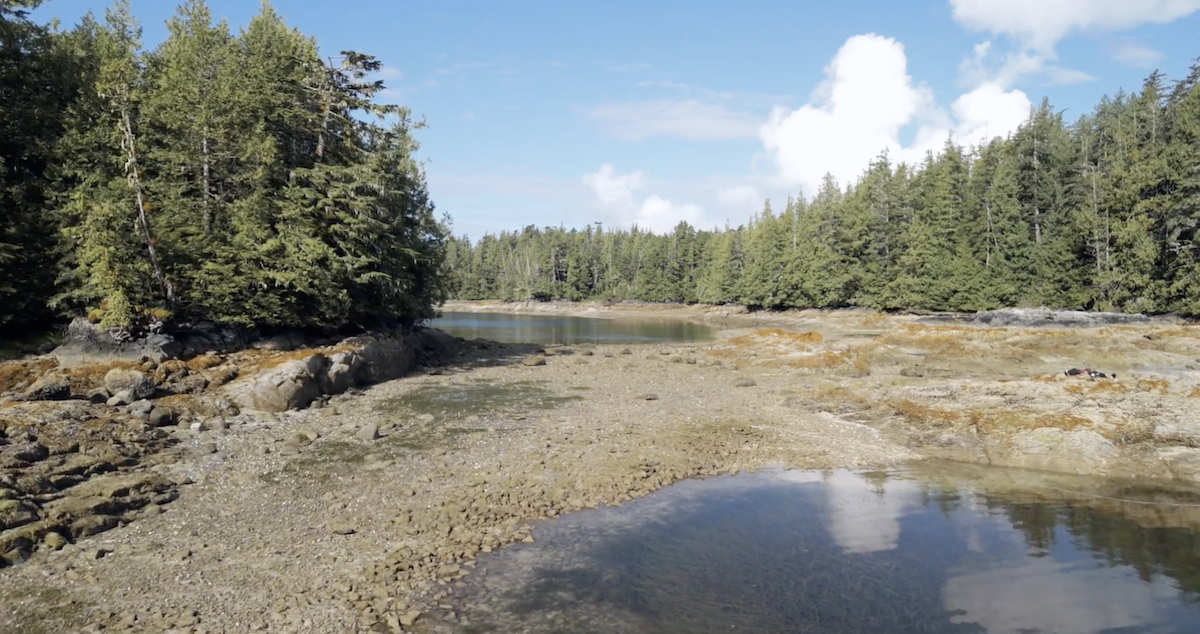
Infrastructure is often thought of as physical objects built from concrete, steel, and timber, like roads, buildings, water treatment plants or energy networks. These are the physical systems, buildings, structures, and facilities that help people carry out daily activities. They are designed and developed by humans to make lives easier, more efficient, and generally to improve quality of life. [1]
"When I think of infrastructure and the people here, I think of the capacity that is built not just in a physical infrastructure, like a building, but the capacity that is built with knowledge, the capacity that's built with the lived experiences of being on the land and the water. It's that unseen infrastructure that's most important to us. Those sets of infrastructures that have been built through knowledge are what's most important, not so much the physical infrastructure that you would normally think of."
- William Housty, HIRMD (Heiltsuk Integrated Resource Management Department), Bella Bella
But increasingly the term infrastructure has grown to include more than this narrow definition. Infrastructure also includes environment based systems and structures of cultural significance. Natural infrastructure, such as managed wetlands, green roofs, restored grasslands, and cultural infrastructures, such as ceremonial spaces, could all be considered infrastructure under a more inclusive definition.
Read More: Build Infrastructure Definition
Built infrastructure refers to human-built physical structures, systems, and facilities that support the needs of people, and the functioning of a community, society, or economy. These structures include transportation systems (such as roads, bridges, and railways), energy systems (including power plants and transmission lines), water and sewage systems, telecommunications, and buildings (like hospitals, schools, and commercial spaces). Built infrastructure is essential for economic activity, public health, safety, and providing necessary services, especially in urban, rural, and Indigenous communities.
Read More: Natural Infrastructure Definition
Natural infrastructure refers to the strategic use of naturally occurring or naturalized spaces that are intentionally managed to provide diverse benefits for the human population and the environment. [2] For example, natural infrastructure such as forests, marches and dunes can protect coastal properties and built infrastructure against erosion and storms. Also, forests and wetlands – natural infrastructure – can reduce the impacts of flooding and may serve to purify water, thereby improving water quality for Indigenous communities, especially those situated downstream. [1]
Natural infrastructure uses elements of nature, such as plants, water, sand, stone, or soil for services that might otherwise be delivered by built infrastructure. These natural features or systems can be naturally occurring, conserved, or restored ecosystems, or aspects of the environment that enhance built infrastructure. [1] Natural infrastructure can actively contribute to climate adaptation and resilience planning by reducing impacts from extreme events. [1]
Read More: Cultural Infrastructure Definition
Cultural infrastructure is defined as human-built systems and structures deeply intertwined with cultural practices, Indigenous governance, and ecological stewardship. These tangible and intangible systems and structures foster the health and well-being of the community, and the land and ecosystems alike. Rooted in Indigenous knowledge systems, cultural infrastructure builds relationships with the land, promotes ecological balance and the continuity of cultural traditions for future generations.
Cultural infrastructure includes structures like clam beds, fishing weirs, trade routes, harvesting and processing facilities, maintenance of agricultural sites and harvesting areas, and management methods such as controlled burns of grasslands and forested areas. Cultural infrastructure is deeply rooted in cultural identity.
This definition of cultural infrastructure was derived from conversation and collaboration with community members from First Nations across what is known as Canada. This distinction aims to represent infrastructure that may be otherwise overlooked using mainstream definitions of infrastructure.
First Nations communities are on the frontlines of climate change. Extreme events such as flooding, drought, extreme heat, wildfire, permafrost thaw, and coastal erosion are already being experienced. Climate change is making these events worse. [3][4][5]
Climate change can disrupt community services, and traditional territories, causing impacts to the ways that First Nations have used their lands for their traditional activities such as hunting, medicine gathering, berry picking, spiritual events, fishing, and trapping.
These changes also affect the infrastructure found in communities.
“You know, climate change is around us. It's upon us.” says Melissa Shawbonquit. She is the Infrastructure Specialist at North Shore Tribal Council, representing the seven communities in the Robinson-Huron Treaty area. Shawbonquit knows that “the longer you hold onto your assets, the more it does for your community”. She has first-hand experience working with communities along the north shore of Lake Huron to help them understand the impacts of climate change on infrastructure, and how to plan. “We've noticed over the years that our facilities are being impacted by climate change. So now, we're reconsidering what we need to do next. What's the alternative?”
While there’s a lot to consider when planning for climate change, Shawbonquit understands that First Nations communities have a tremendous capacity to respond. “We have the tools, we just need to be able to bring them forward.”
The Infrastructure Gap and Climate Change
While communities have great capacity, they are still dealing with the legacy of colonialism. Compared to municipalities and urban centers in Canada, there has been a longstanding gap in the state of infrastructure in First Nations communities. Most on-reserve housing, transportation, and utility infrastructures do not meet the current and growing needs of communities. This gap is a result of consistent under-funding leaving a significant amount of on-reserve assets in poor condition. [3] This means when climate disasters hit, it hits First Nations communities harder.
It’s estimated that it will cost $349.2 billion to close the infrastructure gap between First Nations communities and the rest of Canada. Of this amount approximately $30.9 billion is needed to ensure First Nations infrastructure is climate resilient. [3]
This is among a number of unique challenges that First Nations communities face that can make their infrastructure more vulnerable to the impacts of climate change. [3] In Northwest Angle #33, a small community on Lake of the Woods near the Ontario - United States border, Band Councillor Melvin Blackhawk explains how his community is impacted by a changing climate.
“We live in this remote community with no road access, only accessible by boat in the summertime and ice road in the wintertime. With the road issues and climate change, the shorter period for the ice, there's a time where we can't even go anywhere.“

Climate change is creating warmer, and short winters. For infrastructure that relies on cold weather, most notably ice roads, these changes cause a significant disruption to daily activities. For Band Councillor Blackhawk and the community of Northwest Angle #33b, a lack of an all-season road and the impacts of a warming climate are limiting their ability to move people and materials in and out of their community.
Coastal Communities and Natural Infrastructure
Off the west coast of British Columbia, the impacts of climate change are somewhat different, but they are being experienced just the same. The territory of the Haiłzaqv Nation is located in what is currently known as Bella Bella, on an island that is accessible only by boat or ferry. The history of the Haiłzaqv in this territory dates back at least 14,000 years, and the oral histories and ancestral knowledge provide a glimpse of how climate change has impacted the ecosystems, natural, and cultural infrastructure in the area. “What you see is beautiful, but for our people who have recorded in a collective memory this incredible abundance, there's been an incredible decline.” says Hereditary Heiltsuk Chief Frank Brown.
Desiree Lawson is the Food Sovereignty Coordinator with Haiłzaqv Climate Action. She understands the importance of forging a path forward for her community. Desiree completed her Masters degree focusing on the impact of sea level rise on the clam gardens. The clam gardens in Bella Bella are rock wall enclosures built on the coastline thousands of years ago, and Lawson’s research has determined that these enclosures increase “the abundance of [clams] anywhere from 2 to 4 times a non-walled beach”.

Clam gardens are an important piece of infrastructure to the community. Lawson is clear that the priorities of the community were critical in determining her research. “It was really important to make sure that the work that I did was something that was going to be useful for my nation, something that they wanted to learn more about. They identified clam gardens and sea level rise and future proofing of those glabetsi* because they are really important areas for clams.”
Read more: *Glabetsi, an example of culture infrastructure
“Glabetsi and enheschtok translated is “digging within an enclosure”, so if you have the land and then the rock wall that was built for the clams inside of that you are digging within that enclosure. This rock wall was built 1000 years ago and it is still such an amazing area for so much life” - Desiree Lawson
Clam gardens are a form of cultural infrastructure constructed by First Nations along the west coast of North America. Clam gardens are an enhanced habitat for clam species through the creation of rock wall enclosures. These gardens increase shellfish productivity. Clams are important for coastal First nations as a food source and hold cultural significance. The ongoing maintenance of these gardens supports community food security, as well as cultural continuity.


Chief Brown notes that clam gardens are not the only critical pieces of natural and cultural infrastructure in their territory that are being impacted “We have great concerns about the health of the ocean and the decline of things that give us sustenance, like the salmon and the herring which depend on cold water to survive... The water is in fact warming, and the ocean is acidifying.”
He goes on to communicate the responsibility that has been placed on the Heiltsuk community in dealing with these changes “... and we're the ones that are trying to make the best of the situation and trying to enhance the salmon and the herring and all of the resources that we depend on so that we can maintain our existence and our homelands” Chief Brown’s call to action is direct “We have to figure out our path going forward.”
More than just infrastructure
The infrastructure that serves First Nations communities is essential to the delivery of critical services such as education, health, and connectivity with surrounding communities and larger municipalities. When communities can’t build infrastructure, they lose opportunities for those services. “With the road issues, it stalls a lot of projects, causing havoc with regards to building new infrastructure in the community, like housing.” Says Councillor Blackhawk of Northwest Angle #33. “It's hard to bring in material, especially heavy loads with the thinner ice.”
In Northwest Angle #33, the impacts of climate change can disrupt services and create barriers for long-term initiatives. A lack of an all-season road and the challenges of a shorter ice road season are affecting what the community can build. Chief Darlene Commigan of Northwest Angle #33 explains. “We need the ice road for building material, wood and for people to get it back and forth. Otherwise, we’ve got nothing.” For Chief Commigan, it is more than just the buildings. Youth, education, and the future of the community are the driving force. “We don't hear any kids here, and that's the sad part. We've been trying to get a road into our community. That gives us the opportunity to have a school.”
Not having a school within the community has larger implications. Chief Commigan further notes “Not having a school, that's a big issue. We pay over a million dollars for tuition fees for our students to attend off reserve. That's almost like going into another residential school system. That's not fair to our kids who would rather be home living in the community where their parents grew up. You know, they're losing their cultural identity.” For Northwest Angle #33, the gap in infrastructure and the impacts of climate change are challenging their sense of community and way of life.
In Bella Bella these impacts to infrastructures have led the community to think about how to ensure essential services and ways of life in the community. “We’re contemplating these very questions around food security, about energy security, about our infrastructure, and how our community can continue to exist in our homelands” and for Chief Brown this path forward requires an approach that “...takes the best of what Western science has to offer, but stays true to our ancestral teachings.”
Climate Action and Partnerships in Community
“A lot of people are saying it's a shift. Sagamok knows that, Atikameksheng knows that, Batchewana, Garden River. We all know what it is and why it's happening, but what can we do to, one, mitigate it and, two, adapt to it? ” Shawbonquit reflects on her experience working with the communities on the North Shore of Lake Huron.“We don't always want to be in adaptation mode, we want to try and mitigate the problem before it happens, especially with our infrastructure.”
The way communities are moving forward is through planning for climate change. This can take many different forms, and First Nations communities have been planning and adapting for millenia.
Drew Hill, Director of Engineering and Infrastructure Services at the Ontario First Nations Technical Services Centre, is Mohawk from Six Nations of the Grand River and he has spent many years helping communities as they prepare their assets for a changing climate.
Hill speaks of the rich histories of planning and management in communities “Throughout our history, the stories we tell are a lot about the management of scarce resources. This is something we have been doing our whole existence.” He articulates how this history is guiding First Nations’ ability to navigate the complexities of preparing for and responding to a changing climate. “Applying that mindset to today’s modern infrastructure, we are still at the forefront of managing scarce resources, whether that's a financial resource or operating a water treatment plant or roads or whatnot, we have to meet needs based on a scarcity of resources and for a lot of Indigenous cultures that’s a lot of what we do.”
Communities have already done significant work to become more climate resilient, but Chief Brown says “There's more work that needs to be done.” And First Nations communities can’t do it alone. “We have good allies and good partners that recognize that we need to move forward together to make sure that things are done in a sustainable way.”
References
- Canadian Council of Ministers for the Environment. Natural Infrastructure Framework: Key Concepts, Definitions, and Terms. 2021. https://ccme.ca/en/res/niframework_en.pdf
- Méthot, Pierre-Olivier, and Amanda Rawluk. 2023. State of Play Report for Natural Infrastructure in the Prairies. Winnipeg: International Institute for Sustainable Development.https://www.iisd.org/system/files/2023-05/state-of-play-natural-infrastructure-canadian-prairies.pdf
- Assembly of First Nations. Closing the Infrastructure Gap by 2030: A Collaborative and Comprehensive Cost Estimate Identifying the Infrastructure Investment Needs of First Nations in Canada. March 2023. https://afn.bynder.com/m/367574a3a5cb5abe/original/1-AFN-Closing-the-Infrastructure-Gap-by-2030-National-Cost-Estimate-English-report-1.pdf
- Reed, G., Fox, S., Littlechild, D., McGregor, D., Lewis, D., Popp, J., Wray, K., Kassi, N., Ruben, R., Morales, S. and Lonsdale, S. (2024). For Our Future: Indigenous Resilience Report. Ottawa, Ontario. https://changingclimate.ca/site/assets/uploads/sites/7/2024/03/Indigenous-Resilience-Report_Final_EN.pdf
- Bush, E. and Lemmen, D.S., editors (2019): Canada’s Changing Climate Report; Government of Canada, Ottawa, ON. 444 p. https://changingclimate.ca/CCCR2019/
Recommended Article Citation
Climate Atlas of Canada. (n.d.) First Nations Infrastructure and Climate Change. Prairie Climate Centre. https://climateatlas.ca/first-nations-infrastructure-and-climate-change









.png)


